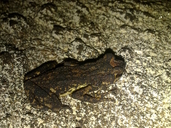|
Adenomus kelaartii (Günther, 1858)
Kelaart`s Dwarf Toad | family: Bufonidae genus: Adenomus |
 © 2011 Waruna Agalawatta (1 of 13) |
|
|
|
Description Distribution and Habitat Country distribution from AmphibiaWeb's database: Sri Lanka
This species is endemic to Sri Lanka where it is found in the wet zone, specially in the remaining parts of the rainforests: Kanneliya, Sinharaja, Peak Wilderness, Kitulgala up to 1230m NN (Dutta and Manamendra 1996; Manamendra and Pethiyagoda 1998). Adenomus kelaartii lives in the leaf litter near near streams. Sometimes it can be found on sand banks at river sites. Females climb up tree to heights of 15 m (Dutta and Manamendra 1998); the author of this account found one in a tree hole two meters above the ground. Life History, Abundance, Activity, and Special Behaviors Trends and Threats Possible reasons for amphibian decline Habitat modification from deforestation, or logging related activities
References
Dutta, S.K. and Manamendra-Arachchi, K. (1996). The Amphibian Fauna of Sri Lanka. Wildlife Heritage Trust of Sri Lanka, Colombo, Sri Lanka. Haas, W., Lehr, E., and Köhler, G. (1997). ''The tadpole of Bufo kelaartii Günther 1859 from Sri Lanka.'' Lyriocephalus, 3(2), 2-6. Manamendra-Arachchi, K., and Pethiyagoda, R. (1998). ''A synopsis of the Sri Lankan Bufonidae (Amphibia: Anura), with description of two new species.'' Journal of South Asian Natural History, 3(2), 213-248. Originally submitted by: Peter Janzen (first posted 2005-04-25) Edited by: Tate Tunstall (2005-04-27) Species Account Citation: AmphibiaWeb 2005 Adenomus kelaartii: Kelaart`s Dwarf Toad <https://amphibiaweb.org/species/211> University of California, Berkeley, CA, USA. Accessed May 17, 2025.
Feedback or comments about this page.
Citation: AmphibiaWeb. 2025. <https://amphibiaweb.org> University of California, Berkeley, CA, USA. Accessed 17 May 2025. AmphibiaWeb's policy on data use. |



 Map of Life
Map of Life